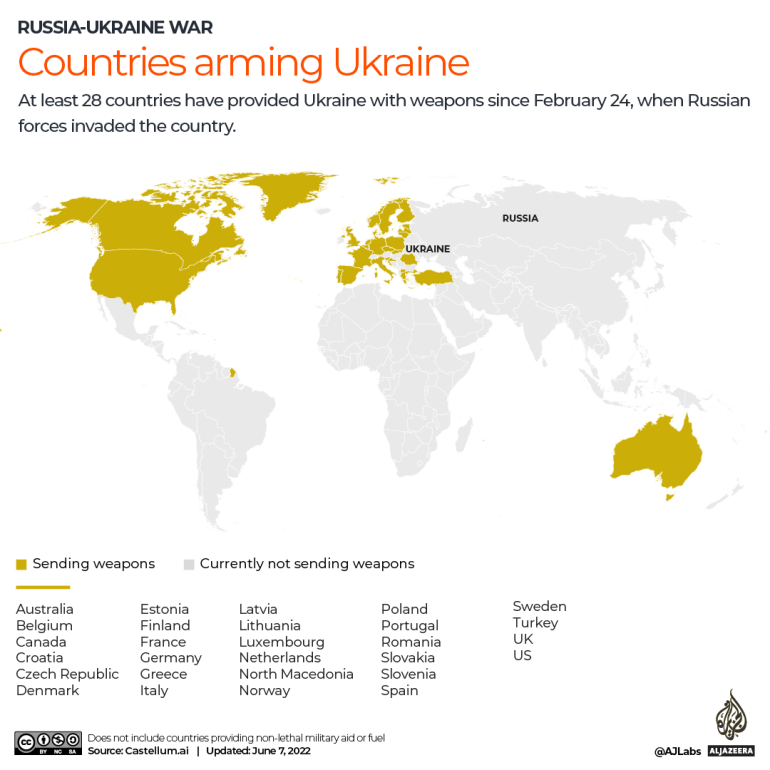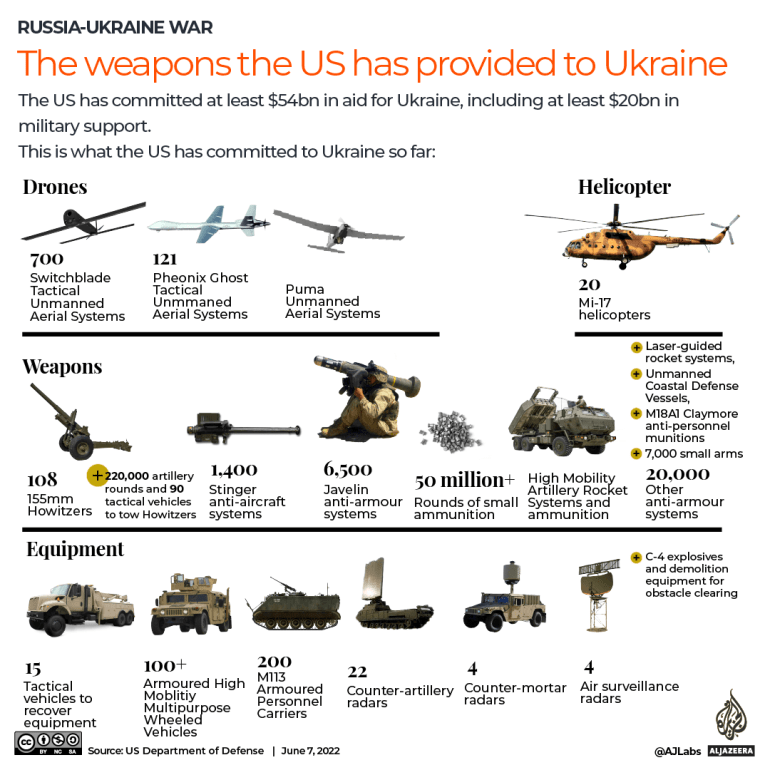But how much support has Ukraine received, and what difference has it made?
Only last week, US President Joe Biden pledged another $45bn in support for Ukraine – a package Congress will now negotiate over. If the proposal is passed, it would be the fourth US aid package for Ukraine and the total money allocated for Ukraine since February would be nearly $100bn.
These staggering figures have led Russian apologist voices such as Republican Representative Marjorie Taylor Greene to claim that Ukraine has turned into a proxy war conducted by the US and against Russia. But it is not merely the fringe of the Grand Old Party that seems inclined to repeat Russian propaganda.
British newspaper The Independent published an opinion piece by its US correspondent titled: “It’s time to stop pretending what’s happening in Ukraine is anything other than a US proxy war.”

Meanwhile, various international relations scholars and other experts in the field beg to differ.
“It is clearly not a proxy war,” Vladimir Rauta, a lecturer in politics and international relations at the University of Reading, told Al Jazeera.
“Proxy wars are indirect wars, often waged covertly, deniably, and outside the bounds of international law. The US-Ukraine partnership is a classic case of military and economic bilateral assistance,” he said.
“The only proxy [war] was the one Russia waged against Ukraine since 2014 when it started supporting, training, and covertly aiding separatist groups in the Donbas.”
Tracking war spending
Besides the US, Europe has paid its fair share for this military-economic partnership Rauta refers to.
However, it is difficult to keep track of exactly how much money is being allocated to Ukraine.
Fortunately, the Kiel Institute for the World Economy (IfW), a German research institute, is capable of providing rather accurate numbers based on its Ukraine Support Tracker, which monitors military help, humanitarian services and financial aid for Ukraine from the West.
Nonetheless, calculating these numbers can be a challenge, Andre Frank, an economist at the IfW, told Al Jazeera.
“Primary encumbrances are the availability of information, especially official information, and the price evaluations of items, especially military goods. We solve the former via diligent research work using a multitude of search mechanisms,” he said.
“In general, we take the information from official government sources as given. Whenever no official information is available, or the statements do not allow for sufficient quantification of the donation, we supplement with credible media reports.”
One problem with this method is that the official information from the US or UK on military aid can often be incomplete.
“Our work can only be as good as the [official] publicly released information, and our new measure indicates what countries provide good and transparent information and which do not,” Frank said.
“Finding good prices for military items is solved by mostly relying on contract value from the [Stockholm International Peace Research Institute] arms trade database, which allows calculations of average unit prices. We also stick to our self-set upper bound rule as it allows us to use prices for new goods in order to not underestimate the true value of bilateral support,” he added.
Donor countries vary, however, in terms of data transparency.
“The official and accessible information from the US is up to date and detailed, allowing an accurate estimation of total values of military support and in-kind military support,” said Frank.
“For the EU member states, the picture differs. Eastern European, Baltic and Scandinavian countries are generally transparent when disclosing the number of items and the total value of military aid packages. In the same categories, countries like Spain, Italy and Portugal are very opaque and deliberately withhold information,” he added.
US providing the most support
Germany, Europe’s de facto leader, poses a particular challenge, mainly because Berlin has handed over military equipment from its stocks which had long since been decommissioned or written off – and therefore have no currently valid price assessment.
For example, Germany supplies heavy weapons such as anti-tank equipment and anti-aircraft missiles, but also lighter ones such as machine guns, hand grenades and other ammunition.
On the one hand, the military material comes from the stocks of the armed forces, or Bundeswehr, and, on the other hand, from stocks of industry financed by the federal government.
The authorities provide a detailed overview of the deliveries on its website, albeit with a caveat.
“Countries like Germany provide a detailed list of numbers of committed and delivered items, however, with no indication of the value,” Frank said.
“This makes our work incredibly challenging as some of the German-sent items come from Bundeswehr stocks, which have been in service for up to over 10 years, making finding good price estimates nearly impossible,” he said.
Unsurprisingly, the US has provided the most military support for Ukraine by a significant margin, based on the IfW’s numbers.
“The biggest contributor of military aid is by far the US with current commitments of 22.86 billion euros ($24.37bn). The United Kingdom has committed the second-largest amount, 4.13 billion euros ($4.40bn),” Frank said.

Indeed, the UK has been one of the largest arms suppliers to Ukraine.
The government in London has delivered or promised Ukraine, among other things, M270 multiple rocket launchers, thousands of anti-tank weapons, hundreds of short-range missiles, armoured vehicles and some Starstreak anti-aircraft systems.
Shortly after taking office, the UK’s Prime Minister Rishi Sunak also promised 125 more anti-aircraft missiles.
Germany, meanwhile, ranks third behind the US and UK in terms of military aid outflows, with 2.34 billion euros ($2.49bn) to date.
London and Berlin are responsible for the lion’s share of European support. According to the IfW, EU member states have provided a total of 8.61 billion euros ($9.18bn) for military aid.
Western aid having ‘undeniable impact’
The commitment of the Europeans does not end with military support.
“If we include the European Peace Facility, a military reimbursement scheme run by the European Union, total EU military support increases by 3.1 billion euros ($3.3bn) to a total of 11.71 billion euros ($12.48bn). This includes commitments until November 20,” Frank noted.
But it is also interesting to look at the large total sums of aid to Ukraine: ie all the humanitarian aid, financial aid and military goods provided by the western Ukraine-supporting states together.
With their decision to help Ukraine from January with a further 18 billion euros ($19bn), the EU states and the institutions of the European Union are overtaking the US regarding aid for Ukraine.
Europe will then support Kyiv with a total of 52 billion euros ($55bn) compared with 48 billion euros ($51bn) from the US for “military, financial and humanitarian aid”, IfW said.
Some numbers inevitably tempt one to look for comparisons in which the world has previously supported a nation under siege. However, a coherent precedent is difficult to find, the University of Reading’s Rauta said.
“I think there is a general quest for analogies that would capture today’s situation, yet most will be imperfect. Rather than thinking comparatively and in part erroneously, one should focus on the continuous support for Ukraine,” he said.
“Its undeniable impact – from intelligence sharing to the recently approved $1.8bn package – has allowed Ukraine to withstand the Russian aggression in ways few expected.”
Faced with these enormous sums, pro-Russian voices are spreading arguments more than usual to attack the financial aid as misguided or warmongering.
All too often, it is argued that aid for Ukraine is disproportionately higher than Russia’s defence budget.
However, according to the British Ministry of Defence’s latest intelligence update, Putin has pledged more than 116 billion pounds ($140bn) for his war in Ukraine in 2023 alone, while a recent Reuters news agency analysis put Russia’s total defence and security budget for 2023 at $155bn.
Whether the united front against Russia’s aggression can remain steadfast – particularly under a Republican-led House of Representatives in the US – remains to be seen.
“On the one hand, the success-defeat balance is yet to be decided in favour of either country – each month progresses with its own logic. Ukrainian territorial advances are matched with Russian attacks on infrastructure, and there is talk of a renewed Russian attempt at retaking Kyiv with a further January-February mobilisation,” Rauta said.
“On the other hand, the steadfast Ukrainian resolve to repel Russia’s aggression is matched by Russia’s lack of commitment to peace,” he added.
“Whatever 2023 brings, Russian pretence to seek peace will only be sought as a way to buy time, mobilise, and regroup. One can hope that 2023 will bring more support to Ukraine from the transatlantic community facing its gravest security problem in decades,” he said.
